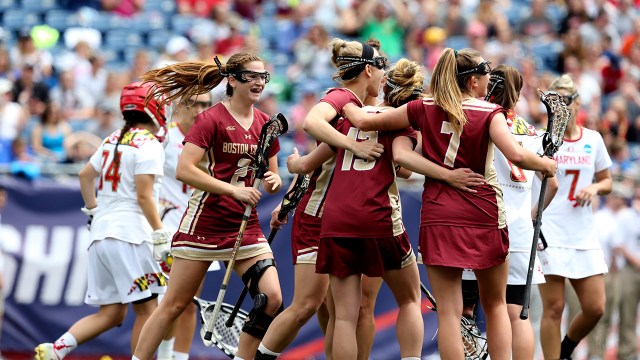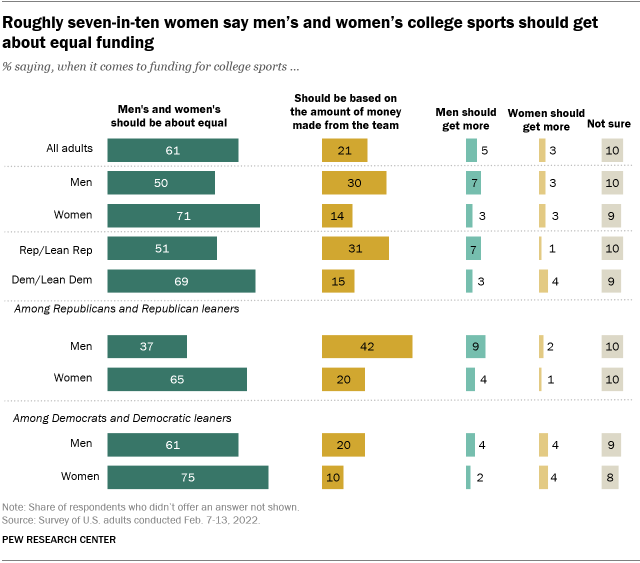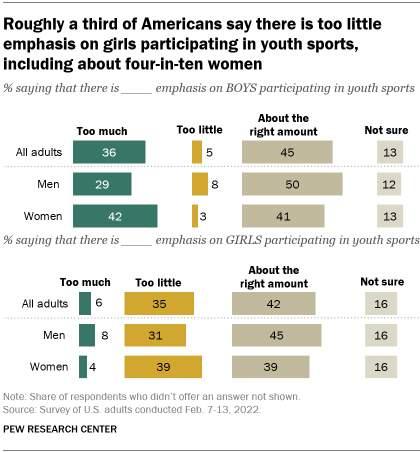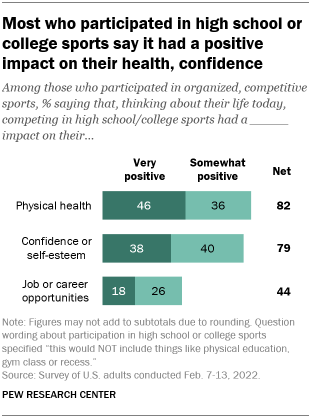
Fifty years after the passage of Title IX, which prohibits high schools and colleges that receive federal funding from discriminating based on sex, most Americans who have heard about the law say it’s had a positive impact on gender equality in the United States (63%). Still, 37% of those who are familiar with Title IX say it has not gone far enough in increasing opportunities for women and girls to participate in sports, according to a February Pew Research Center survey of U.S. adults.

Men and women who have heard about Title IX are about equally likely to say that the law has had a positive impact on gender equality. However, women (46%) are more likely than men (29%) to say the legislation has not gone far enough to increase opportunities for women in sports. A majority of men (54%) say the progress has been about right, compared with 41% of women.
Views on the impact of Title IX vary along party lines: 75% of Democrats and Democratic-leaning independents who have heard of Title IX say it has had a positive impact on gender equality, while 49% of similar Republicans and GOP leaners say the same. Republicans, in turn, are more likely than Democrats to say the law has had a negative impact on gender equality (25% vs. 10%).
Pew Research Center conducted this analysis to better understand Americans’ views on gender equality in sports and the impact of sports participation surrounding the 50th anniversary of Title IX legislation. This analysis is based on 9,388 U.S. adults; the data was collected as a part of a larger survey conducted Feb. 7-13, 2022. Everyone who took part is a member of the Center’s American Trends Panel (ATP), an online survey panel that is recruited through national, random sampling of residential addresses. This way, nearly all U.S. adults have a chance of selection. The survey is weighted to be representative of the U.S. adult population by gender, race, ethnicity, partisan affiliation, education and other categories. Read more about the ATP’s methodology.
Here are the questions used for this analysis, along with responses, and its methodology.
Democrats who are familiar with Title IX are also far more likely than Republicans to say the law has not gone far enough to increase opportunities for girls and women in sports (51% vs. 19%), while Republicans are more likely to say things are about right (57% vs. 41%) or that the law has gone too far (22% vs. 6%).
Democratic women are especially likely to say Title IX has not gone far enough: 60% of Democratic women say this, compared with 42% of Democratic men, 27% of Republican women and 13% of Republican men.
Roughly half of Americans say they have heard a little (37%) or a lot (13%) about Title IX; 50% say they have heard nothing at all about the law. Men (55%) are more likely than women (44%) to say they have heard at least a little about it, and older Americans are more likely to have heard about it than younger Americans. The age gap is especially pronounced among women: Women under age 50 are less likely than women ages 50 and older to have heard of Title IX (41% vs. 48%).
Most Americans say women’s and men’s college sports should get about equal funding
The survey also found about six-in-ten Americans (61%) say funding for women’s and men’s college sports should be roughly equal, but a sizable share (21%) says it should be based on the amount of money brought in by the team. Relatively small shares say either men’s sports should receive more funding than women’s (5%) or women’s sports should receive more than men’s (3%).
Women (71%) are more likely than men (50%) to say that college sports should be equally funded regardless of gender, while men are more likely than women to say funding should be based on the amount of money brought in by the team (30% vs. 14%, respectively). Still, half of men say funding should be equal across genders.

Partisan gaps are also pronounced when it comes to views of funding for college sports. Democrats (69%) are more likely than Republicans (51%) to say men’s and women’s college sports should get about equal funding, while Republicans are much more likely than Democrats to say funding should be based on the amount of money brought in by the team (31% vs. 15%).
The gender gap persists in both parties, though it is particularly wide among Republicans. About two-thirds of Republican women (65%) say funding should be about equal regardless of gender, compared with 37% of Republican men. Republican men, in turn, are about twice as likely as Republican women to say funding should be based on the amount of money brought in by the teams (42% vs. 20%). Among Democrats, majorities of men (61%) and women (75%) say funding should be about equal.
Views on this issue also differ by age, with older Americans more likely than younger Americans to say that men’s and women’s college teams should get about equal funding. Women ages 50 and older are particularly likely to hold this view: 75% say funding should be about equal, compared with 68% of women under 50, 57% of men ages 50 and older and just 44% of men under 50.
More than one-third of Americans say there is too much emphasis on boys participating in youth sports and too little emphasis on girls

Some 36% of Americans say there is too much emphasis on boys participating in youth sports, while 45% say there is about the right amount of emphasis and just 5% say there is too little emphasis. By contrast, when asked about the emphasis placed on girls’ participation, roughly one-third (35%) say there is too little emphasis, while 42% say there is about the right amount and 6% say there is too much emphasis. In both cases, similar shares say they are not sure (13% and 16%, respectively).
Women are more likely than men to say there is too much emphasis on boys participating in youth sports (42% vs. 29%) and that there is too little emphasis on girls participating in youth sports (39% vs. 31%). Men, on the other hand, are more likely than women to say there is the right amount of emphasis on participation for boys (50% vs. 41%) and girls (45% vs. 39%).
The partisan gap in views about gender and youth sports participation is even wider. Democrats are much more likely than Republicans to say there is too much emphasis on boys participating in sports (45% vs. 25%). And Democrats are also much more likely to say there is too little emphasis on girls’ participation: 44% say this, compared with 26% of Republicans. About half or more Republicans say there is the right amount of emphasis for boys (55%) and girls (51%).
Democratic and Republican women are more likely than their male counterparts to say there is too much emphasis on boys participating in sports and too little emphasis on girls participating in sports. Some 32% of Republican women say there is too much emphasis on boys participating in sports, compared with 17% of Republican men. Among Democrats, 50% of women see too much emphasis on boys and sports, while 40% of Democratic men say the same.
Most former high school and college athletes say participating in sports had a positive impact on them, especially when it comes to confidence and physical health
When it comes to people’s own participation in sports, 48% of Americans say they took part in organized, competitive sports either in high school or college – 39% say they participated in high school sports and 9% say they competed in sports in college (including 7% who say they did both).
Men are more likely than women to say they participated in high school or college sports (56% vs. 41%). Among women, those under 50 are more likely than those ages 50 and older to have participated in high school or college sports (48% vs. 33%). Some 11% of men say they did college sports, compared with 7% of women.

Among people who participated in organized, competitive sports in high school or college, most say that their involvement in sports had a positive impact on their health and confidence or self-esteem. More than four-in-ten (46%) say playing sports had a very positive impact on their physical health, and 38% say the same about the impact on their confidence or self-esteem. A smaller share (18%) say participating in competitive sports had a very positive impact on their career or job opportunities. Just over half of competitive athletes (54%) say participating in sports had no impact on their job opportunities. Very few athletes say their participation in sports had a negative impact on their confidence (6%), physical health (5%) or job opportunities (3%).
Across all three measures asked, athletes who played sports in college were more likely than those who only participated in high school sports to say their participation had a very positive impact. For example, 53% of college athletes say that their participation had a very positive impact on their physical health, compared with 44% of athletes who only played in high school.
Assessments of the personal impact of sports differ by race. Larger shares of Black and Hispanic athletes (44% each) than White athletes (36%) say their participation in sports had a very positive impact on their confidence or self-esteem. Black athletes are also more likely than White athletes to say playing sports had a very positive impact on their job opportunities (27% vs. 16%). There are no differences across racial and ethnic groups in reported impact on physical health. There were not enough Asian American athletes in the sample to analyze their experiences separately.
Men and women are roughly equally likely to say that playing competitive sports very positively impacted their health and career opportunities. Men are somewhat more likely to say it had a very positive impact on their confidence (40% vs. 36%).
Note: Here are the questions used for this analysis, along with responses, and its methodology.
